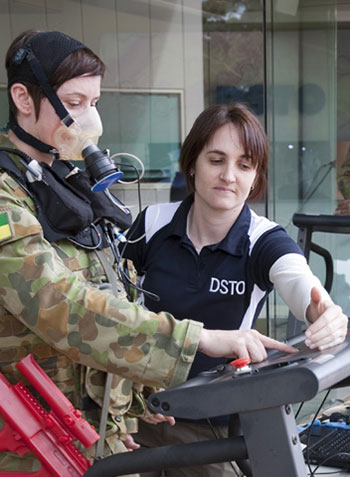Physical Employment Standards

DSTG is developing a set of performance standards that will optimise the matching of personnel capabilities to tasks.
The University of Wollongong is assisting this work through a partnership with DSTG.
The problem with previous work performance standards is that they can lead to individuals either being unnecessarily excluded from a role, or selected for a position for which they are unsuited.
By establishing standards that are truly representative of military tasks, Defence can make an accurate assessment of a person's physical capacity to perform a particular job, regardless of trade classification, rank, age or gender. Better fitness of personnel for the required tasks means improved performance outcomes, reduced injuries, increased availability for operations and training and reduced costs for health care and compensation.
For each of the employment categories within Defence, the process of developing physical employment standards involves:
- undertaking task observation and analysis to identify key employment category tasks to be used for physical employment standards development
- developing employment category-specific physical employment tests and protocols
- refining and verifying these tests and protocols on a representative sample.
This work is being carried out through the Physical Employment Standards Centre of Expertise established by the two organisations in 2009.
| Timeframe | Employment Categories Reviewed |
|---|---|
| June 2006 - August 2007 | Army Artillery (RAA) |
| September 2007 - June 2009 | Army Transport Corps (RACT) Army Ordnance Corps (RAAOC) Army Medical Corps (RAAMC) Army Dental Corps (RAADC) Army Catering Corps (AACC) |
| July 2009 - December 2010 | Army Armoured Corps (RAAC) Army Engineers (RAE) Army Transport Corp (RACT) continued Army Ordnance Corps (RAAOC) continued Army Electrical and Mechanical Engineers (RAEME) |
| November 2010 - December 2011 | Army Artillery (RAA) continued Army Infantry (RAINF) Army Aviation (AAAVN) Air Force Airfield Defence Guards Navy Clearance Diver |
| October 2011 - December 2012 | Army Artillery (RAA) continued Army Signals Corps (RASIGS) Army Australian Intelligence (AUSTINT) Army Military Police (RACMP) Army Band Corps (AABC) Army Infantry Special Forces (RAINF-SF) Army Transport Corps (RACT) continued |
| January 2013 - June 2016 | Remaining Air Force employment categories as well as developing a generic seagoing standard for Navy. |
| July 2016 - June 2019 | Remaining Navy employment categories. |

